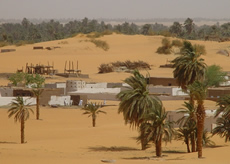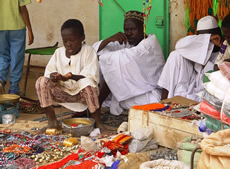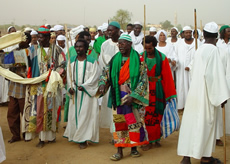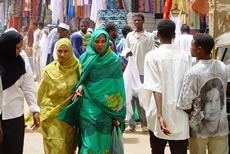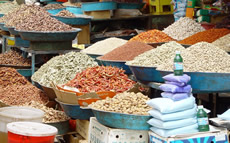|
Sudan – The country and its history With a land area of 2,376,000 square kilometres and a coastline of 716 kilometres, Sudan is the largest country in Africa. Plateaus and plains predominate. Mountainous areas lie behind the Red Sea coast, in far south, and in far west. Only interior highlands of consequence are Nuba Mountains west of white Nile River. All significant streams flow to White Nile and Blue Nile rivers, which join just north of Khartoum to form River Nile. Extensive swamps in south, especially along Bahr al Ghazal (southernmost part of White Nile). Rainfall ranges from rare and occasional in far northern desert to relatively abundant and frequent (rainy seasons of six to nine months) in southern third of Sudan. In most years central third has enough rain for agriculture but lack of rain in 1980s and 1991 has caused years of drought. Dust storms (often preceding rainstorms) common in north and northern parts of central Sudan, reducing visibility and causing much discomfort. Mean temperatures and daily maximums generally high; desert temperatures often quite cool at night. The census of 1983 set population at 21.6 million people; July 1990 population estimate approximately 25 million. Annual growth rate between 2.8 and 3.1 percent. Half of population under eighteen years of age. About 20 percent of population urban, concentrated chiefly in three cities--Khartoum, Omdurman, and Khartoum North--constituting national capital area. There are about 400 languages, but Arabic is the primary and official language. English is a common second language in south. Other languages include Bedawiye used by Beja and various dialects of Niger-Kurdufanian and Nilo-Saharan. The largest ethnic category in 1983 (nearly 40 percent of total, nearly 55 percent in north) comprises those considering themselves Arabs, but category internally split by regional and tribal loyalties and affiliation to various Muslim politico-religious groups. Major Muslim (but non-Arab) groups are Nubians in far north, nomadic Beja in northeast, and Fur in west. Southern non-Muslim groups include Dinka (more than 10 percent of total population and 40 percent in south), Nuer, and numerous smaller Nilotic and other ethnic groups. More than half of the total population are Muslim, most living in north where Muslims constitute 75 percent or more of population. Relatively few Christians, most living in south. Most people in south and substantial minority in north adherents of various indigenous religions. Agriculture and livestock raising provided livelihood for about 80 percent of population and roughly 95 percent of exports in early 1990s. Agriculture characterized by modern market-oriented sector of irrigated and mechanized rainfed farming concentrated in central part of country and large traditional sector engaged in subsistence activities elsewhere. Principal modern sector crops are cotton, sorghum, groundnuts, sugarcane, wheat, sesame. Traditional sector crops are sorghum, millet, sesame, groundnuts. Fisheries still largely subsistence occupation.
SUDAN, LIKE MANY AFRICAN COUNTRIES, consists of numerous ethnic groups. Unlike most states, however, Sudan has two distinct divisions: the north, which is largely Arab and Muslim, and the south, which consists predominantly of black Nilotic peoples, some of whom are members of indigenous faiths and others who are Christians. British policy during the Anglo-Egyptian condominium (1899-1955) intensified the rift because Britain established separate administrations for the two areas and forbade northerners to enter the south. In the 1990s, many southerners continued to fear being ruled by northerners, who lacked familiarity with their beliefs and ethnic traditions and sought to impose northern institutions on them. Given its proximity to Egypt and the centrality of the Nile River that both countries share, it is not surprising that historically Egypt has influenced Sudan significantly especially the northern part of the country.
CushNorthern Sudan's earliest historical record comes from Egyptian sources, which described the land upstream from the first cataract, called Cush, as "wretched." For more than 2,000 years after the Old Kingdom (ca. 2700-2180 B.C.), Egyptian political and economic activities determined the course of the central Nile region's history. Even during intermediate periods when Egyptian political power in Cush waned, Egypt exerted a profound cultural and religious influence on the Cushite people. Over the centuries, trade developed. Egyptian caravans carried grain to Cush and returned to Aswan with ivory, incense, hides, and carnelian (a stone prized both as jewellery and for arrowheads) for shipment downriver. Egyptian traders particularly valued gold and slaves, who served as domestic servants, concubines, and soldiers in the pharaoh's army. Egyptian military expeditions penetrated Cush periodically during the Old Kingdom. Yet there was no attempt to establish a permanent presence in the area until the Middle Kingdom (ca. 2100-1720 B.C.), when Egypt constructed a network of forts along the Nile as far south as Samnah, in southern Egypt, to guard the flow of gold from mines in Wawat. Around 1720 B.C., Asian nomads called Hyksos invaded Egypt, ended the Middle Kingdom, severed links with Cush, and destroyed the forts along the Nile River. To fill the vacuum left by the Egyptian withdrawal, a culturally distinct indigenous kingdom emerged at Kerma, near present-day Dongola. After Egyptian power revived during the New Kingdom (ca. 1570- 1100 B.C.), the pharaoh Ahmose I incorporated Cush as an Egyptian province governed by a viceroy. Although Egypt's administrative control of Cush extended only down to the fourth cataract, Egyptian sources list tributary districts reaching to the Red Sea and upstream to the confluence of the Blue Nile and White Nile rivers. Egyptian authorities ensured the loyalty of local chiefs by drafting their children to serve as pages at the pharaoh's court. Egypt also expected tribute in gold and slaves from local chiefs. Once Egypt had established political control over Cush, officials and priests joined military personnel, merchants, and artisans and settled in the region. The Coptic language, spoken in Egypt, became widely used in everyday activities. The Cushite elite adopted Egyptian gods and built temples like that dedicated to the sun god Amun at Napata, near present-day Kuraymah. The temples remained centres of official religious worship until the coming of Christianity to the region in the sixth century. When Egyptian influence declined or succumbed to foreign domination, the Cushite elite regarded themselves as champions of genuine Egyptian cultural and religious values. By the eleventh century B.C., the authority of the New Kingdom dynasties had diminished, allowing divided rule in Egypt, and ending Egyptian control of Cush. There is no information about the region's activities over the next 300 years. In the eighth century B.C., however, Cush re-emerged as an independent kingdom ruled from Napata by an aggressive line of monarchs who gradually extended their influence into Egypt. About 750 B.C., a Cushite king called Kashta conquered Upper Egypt and became ruler of Thebes until approximately 740 B.C. His successor, Piankhy, subdued the delta, reunited Egypt under the Twenty-fifth Dynasty, and founded a line of kings who ruled Cush and Thebes for about a hundred years. The dynasty's intervention in the area of modern Syria caused a confrontation between Egypt and Assyria. When the Assyrians in retaliation invaded Egypt, Taharqa (688-663 B.C.), the last Cushite pharaoh, withdrew and returned the dynasty to Napata, where it continued to rule Cush and extended its dominions to the south and east.
MeroeEgypt's succeeding dynasty failed to reassert control over Cush. In 590 B.C., however, an Egyptian army sacked Napata, compelling the Cushite court to move to a more secure location at Meroe near the sixth cataract. For several centuries thereafter, the Meroitic kingdom developed independently of Egypt, which passed successively under Persian, Greek, and, finally, Roman domination. During the height of its power in the second and third centuries B.C., Meroe extended over a region from the third cataract in the north to Sawba, near present-day Khartoum, in the south. The pharaonic tradition persisted among a line of rulers at Meroe, who raised stelae to record the achievements of their reigns and erected pyramids to contain their tombs. These objects and the ruins of palaces, temples, and baths at Meroe attest to a centralized political system that employed artisans' skills and commanded the labour of a large work force. A well-managed irrigation system allowed the area to support a higher population density than was possible during later periods. By the first century B.C., the use of hieroglyphs gave way to a Meroitic script that adapted the Egyptian writing system to an indigenous, Nubian-related language spoken later by the region's people. Meroe's succession system was not necessarily hereditary; the matriarchal royal family member deemed most worthy often became king. The queen mother's role in the selection process was crucial to a smooth succession. The crown appears to have passed from brother to brother (or sister) and only when no siblings remained from father to son. Although Napata remained Meroe's religious centre, northern Cush eventually fell into disorder as it came under pressure from the Blemmyes, predatory nomads from east of the Nile. However, the Nile continued to give the region access to the Mediterranean world. Additionally, Meroe maintained contact with Arab and Indian traders along the Red Sea coast and incorporated Hellenistic and Hindu cultural influences into its daily life. Inconclusive evidence suggests that metallurgical technology may have been transmitted westward across the savanna belt to West Africa from Meroe's iron smelteries. Relations between Meroe and Egypt were not always peaceful. In 23 B.C., in response to Meroe's incursions into Upper Egypt, a Roman army moved south and razed Napata. The Roman commander quickly abandoned the area, however, as too poor to warrant colonization. In the second century A.D., the Nobatae occupied the Nile's west bank in northern Cush. They are believed to have been one of several well-armed bands of horse- and camel-borne warriors who sold protection to the Meroitic population; eventually they intermarried and established themselves among the Meroitic people as a military aristocracy. Until nearly the fifth century, Rome subsidized the Nobatae and used Meroe as a buffer between Egypt and the Blemmyes. Meanwhile, the old Meroitic kingdom contracted because of the expansion of Axum, a powerful Abyssinian state in modern Ethiopia to the east. About A.D. 350, an Axumite army captured and destroyed Meroe city, ending the kingdom's independent existence.
Christian NubiaBy the sixth century, three states had emerged as the political and cultural heirs of the Meroitic kingdom. Nobatia in the north, also known as Ballanah, had its capital at Faras, in what is now Egypt; the central kingdom, Makuria, was centred at Dongola, the old city on the Nile about 150 kilometres south of modern Dongola; and Alwa, in the heartland of old Meroe in the south, had its capital at Sawba. In all three kingdoms, warrior aristocracies ruled Meroitic populations from royal courts where functionaries bore Greek titles in emulation of the Byzantine court. The earliest references to Nubia's successor kingdoms are contained in accounts by Greek and Coptic authors of the conversion of Nubian kings to Christianity in the sixth century. According to tradition, a missionary sent by Byzantine empress Theodora arrived in Nobatia and started preaching the gospel about 540. It is possible that the conversion process began earlier, however, under the aegis of Coptic missionaries from Egypt, who in the previous century had brought Christianity to the Abyssinians. The Nubian kings accepted the Monophysite Christianity practiced in Egypt and acknowledged the spiritual authority of the Coptic patriarch of Alexandria over the Nubian church. A hierarchy of bishops named by the Coptic patriarch and consecrated in Egypt directed the church's activities and wielded considerable secular power. The church sanctioned a sacerdotal kingship, confirming the royal line's legitimacy. In turn the monarch protected the church's interests. The queen mother's role in the succession process paralleled that of Meroe's matriarchal tradition. Because women transmitted the right to succession, a renowned warrior not of royal birth might be nominated to become king through marriage to a woman in line of succession. The emergence of Christianity reopened channels to Mediterranean civilization and renewed Nubia's cultural and ideological ties to Egypt. The church encouraged literacy in Nubia through its Egyptian-trained clergy and in its monastic and cathedral schools. The use of Greek in liturgy eventually gave way to the Nubian language, which was written using an indigenous alphabet that combined elements of the old Meroitic and Coptic scripts. Coptic, however, often appeared in ecclesiastical and secular circles. Additionally, early inscriptions have indicated a continuing knowledge of colloquial Greek in Nubia as late as the twelfth century. After the seventh century, Arabic gained importance in the Nubian kingdoms, especially as a medium for commerce. The Christian Nubian kingdoms, which survived for many centuries, achieved their peak of prosperity and military power in the ninth and tenth centuries. However, Muslim Arab invaders, who in 640 had conquered Egypt, posed a threat to the Christian Nubian kingdoms. Most historians believe that Arab pressure forced Nobatia and Muqurra to merge into the kingdom of Dongola sometime before 700. Although the Arabs soon abandoned attempts to reduce Nubia by force, Muslim domination of Egypt often made it difficult to communicate with the Coptic patriarch or to obtain Egyptian-trained clergy. As a result, the Nubian church became isolated from the rest of the Christian world.
The coming of Islam The coming of Islam eventually changed the nature of Sudanese society and facilitated the division of the country into north and south. Islam also fostered political unity, economic growth, and educational development among its adherents; however, these benefits were restricted largely to urban and commercial centers. The spread of Islam began shortly after the Prophet Muhammad's death in 632. By that time, he and his followers had converted most of Arabia's tribes and towns to Islam (literally, submission), which Muslims maintained united the individual believer, the state, and society under God's will. Islamic rulers, therefore, exercised temporal and religious authority. Islamic law, which was derived primarily from the Quran, encompassed all aspects of the lives of believers, who were called Muslims ("those who submit" to God's will). Within a generation of Muhammad's death, Arab armies had carried Islam north and east from Arabia into North Africa. Muslims imposed political control over conquered territories in the name of the caliph (the Prophet's successor as supreme earthly leader of Islam). The Islamic armies won their first North African victory in 643 in Tripoli (in modern Libya). However, the Muslim subjugation of all of North Africa took about seventy-five years. The Arabs invaded Nubia in 642 and again in 652, when they laid siege to the city of Dongola and destroyed its cathedral. The Nubians put up a stout defence, however, causing the Arabs to accept an armistice and withdraw their forces.
The Arabs Contacts between Nubians and Arabs long predated the coming of Islam, but the arabization of the Nile Valley was a gradual process that occurred over a period of nearly 1,000 years. Arab nomads continually wandered into the region in search of fresh pasturage, and Arab seafarers and merchants traded in Red Sea ports for spices and slaves. Intermarriage and assimilation also facilitated arabization. After the initial attempts at military conquest failed, the Arab commander in Egypt, Abd Allah ibn Saad, concluded the first in a series of regularly renewed treaties with the Nubians that, with only brief interruptions, governed relations between the two peoples for more than 600 years. So long as Arabs ruled Egypt, there was peace on the Nubian frontier; however, when non-Arabs acquired control of the Nile Delta, tension arose in Upper Egypt. The Arabs realized the commercial advantages of peaceful relations with Nubia and used the treaty to ensure that travel and trade proceeded unhindered across the frontier. The treaty also contained security arrangements whereby both parties agreed that neither would come to the defence of the other in the event of an attack by a third party. The treaty obliged both to exchange annual tribute as a goodwill symbol, the Nubians in slaves and the Arabs in grain. This formality was only a token of the trade that developed between the two, not only in these commodities but also in horses and manufactured goods brought to Nubia by the Arabs and in ivory, gold, gems, gum arabic, and cattle carried back by them to Egypt or shipped to Arabia. Acceptance of the treaty did not indicate Nubian submission to the Arabs, but the treaty did impose conditions for Arab friendship that eventually permitted Arabs to achieve a privileged position in Nubia. For example, provisions of the treaty allowed Arabs to buy land from Nubians south of the frontier at Aswan. Arab merchants established markets in Nubian towns to facilitate the exchange of grain and slaves. Arab engineers supervised the operation of mines east of the Nile in which they used slave labor to extract gold and emeralds. Muslim pilgrims en route to Mecca travelled across the Red Sea on ferries from Aydhab and Sawakin, ports that also received cargoes bound from India to Egypt. Traditional genealogies trace the ancestry of most of the Nile Valley's mixed population to Arab tribes that migrated into the region during this period. Even many non-Arabic-speaking groups claim descent from Arab forebears. The two most important Arabic-speaking groups to emerge in Nubia were the Jaali and the Juhayna (see Ethnic Groups , ch. 2). Both showed physical continuity with the indigenous pre-Islamic population. The former claimed descent from the Quraysh, the Prophet Muhammad's tribe. Historically, the Jaali have been sedentary farmers and herders or townspeople settled along the Nile and in Al Jazirah. The nomadic Juhayna comprised a family of tribes that included the Kababish, Baqqara, and Shukriya. They were descended from Arabs who migrated after the thirteenth century into an area that extended from the savannah and semi desert west of the Nile to the Abyssinian foothills east of the Blue Nile. Both groups formed a series of tribal shaykhdoms that succeeded the crumbling Christian Nubian kingdoms and that were in frequent conflict with one another and with neighbouring non-Arabs. In some instances, as among the Beja, the indigenous people absorbed Arab migrants who settled among them. Beja ruling families later derived their legitimacy from their claims of Arab ancestry. Although not all Muslims in the region were Arabic-speaking, acceptance of Islam facilitated the arabizing process. There was no policy of proselytism, however, and forced conversion was rare. Islam penetrated the area over a long period of time through intermarriage and contacts with Arab merchants and settlers. Exemption from taxation in regions under Muslim rule also proved a powerful incentive to conversion. . Following the Muslim conquest of the area, in 1276 the Mamluk rulers of Egypt gave Nubia to a Muslim overlord. The Nubians themselves converted to Islam only gradually; a majority of them remained Christian until the fifteenth or sixteenth century. During the sixteenth century, the Muslim religious brotherhoods spread through northern Nubia, and the Ottoman Empire exerted its jurisdiction through military leaders whose rule endured for three centuries. In 1820 Muhammad Ali, who ruled Egypt on behalf of the Ottomans, sent 4,000 troops to Sudan to clear the area of Mamluks. The invasion resulted in Ottoman-Egyptian rule of Sudan from 1821 to 1885; the rule was accompanied by the introduction of secular courts and a large bureaucracy. The 1880s saw the rise of the Mahdist movement, consisting of disciples of Muhammad Ahmad ibn as Sayyid Abd Allah, a Sudanese who proclaimed himself the Mahdi or "guided one," and launched a jihad against the Ottoman rulers. Britain perceived the Mahdists as a threat to stability in the region and sent first Charles George Gordon and then Herbert Kitchener to Sudan to assert British control. The British conquest led to the establishment of the Anglo-Egyptian condominium and, initially, to military rule of Sudan, followed by civilian administration. Britain largely ignored southern Sudan until after World War I, leaving Western missionary societies to establish schools and medical facilities in the area. After World War I, Sudanese nationalism, which favoured either independence or union with Egypt, gathered popular support. Recognizing the inevitable, Britain signed a self-determination agreement with Sudan in 1952, followed by the Anglo-Egyptian accord in 1953 that set up a three-year transition period to self-government. Sudan proclaimed its independence January 1, 1956. |
|
|
Sunset on the Nile |
|
|
|
|
| African Dancers | |
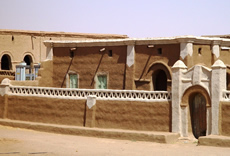 |
|
| Nubian Village near Sdeinga | |
|
|
|
|
Village near Dongola |
|
|
|
|
|
Pyramids of Meroe |
|
|
|
|
|
Pyramids of Meroe |
|
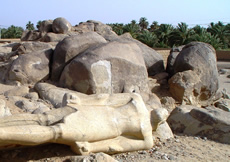 |
|
| Statue of Taharka at Tumbus | |
|
|
|
|
Waiting for the ferry at Umm Tuyur |
|
|
|
|
| Nubian children | |
|
|
|
|
Local ferry |
|
|
|
|
|
Market scene in Omdurman |
|
|
|
|
| Camping at a village near Old Dongola | |
|
|
|
| Ethnoggraphic Museum | |
|
|
|
|
Old Dongola |
|
|
|
|
|
Fresco from Faras |
|
|
|
|
|
Dervishes in Omdurman |
|
|
|
|
|
Darb el Arbain |
|
|
|
|
|
Khartum Street Scene |
|
|
|
|
|
Spices |
|
 |
|
| On Sai Island | |
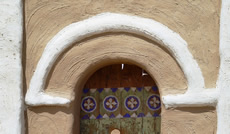 |
|
| Nubian House | |
|
|
|
| On the way to Dongola | |
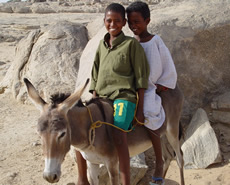 |
|
| Boys near Tumbus | |
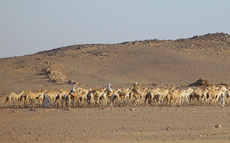 |
|
| Darb el Arbain | |
|
|
|
| Village near Soleb |

